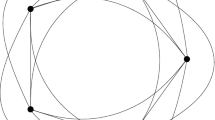Abstract
LetG be a graph ofn vertices that can be drawn in the plane by straight-line segments so that nok+1 of them are pairwise crossing. We show thatG has at mostc k nlog2k−2 n edges. This gives a partial answer to a dual version of a well-known problem of Avital-Hanani, Erdós, Kupitz, Perles, and others. We also construct two point sets {p 1,⋯,p n }, {q 1,⋯,q n } in the plane such that any piecewise linear one-to-one mappingf∶R 2→R 2 withf(pi)=qi (1≤i≤n) is composed of at least Ω(n 2) linear pieces. It follows from a recent result of Souvaine and Wenger that this bound is asymptotically tight. Both proofs are based on a relation between the crossing number and the bisection width of a graph.
Similar content being viewed by others
References
P. K. Agarwal, B. Aronov, J. Pach, R. Pollack, and M. Sharir, Quasi-planar graphs have a linear number of edges,Proc. Graph Drawing '95, Passau (F. J. Brandenburg, ed.), Lecture Notes in Computer Science, Vol. 1207, Springer-Verlag, Berlin, 1996, pp. 1–7.
N. Alon and P. Erdós, Disjoint edges in geometric graphs,Discrete Comput. Geom.,4 (1989), 287–290.
N. Alon and J. Spencer,The Probabilistic Method, Wiley, New York, 1992.
B. Aronov, R. Seidel, and D. Souvaine, On compatible triangulations of simple polygons,Comput. Geom. Theory Appl.,3 (1993), 27–36.
S. Avital and H. Hanani, Graphs,Gilyonot Lematematika,3 (1966), 2–8 (in Hebrew).
V. Capoyleas and J. Pach, A Turán-type theorem on chords of a convex polygon,J. Combin. Theory Ser. B,56 (1992), 9–15.
K. Diks, H. N. Djidjev, O. Sykora, and I. Vřto, Edge separators for planar graphs and their applications,Proc. 13th Symp. on Mathematical Foundations of Computer Science (M. P. Chytil, L. Janiga, V. Koubek, eds.), Lecture Notes in Computer Science, Vol. 324, Springer-Verlag, Berlin, 1988, pp. 280–290.
P. Erdós, On sets of distances ofn points,Amer. Math. Monthly,53 (1946), 248–250.
H. Gazit and G. L. Miller, Planar separators and the Euclidean norm,Algorithms, Proc. International Symp. SIGAL '90 (T. Asanoet al., eds.), Lecture Notes in Computer Science, Vol. 450, Springer-Verlag, Berlin, 1990, pp. 338–347.
W. Goddard, M. Katchalski, and D. J. Kleitman, Forcing disjoint segments in the plane,European J. Combin., to appear.
H. Hopf and E. Pannwitz, Aufgabe No. 167,Jahresber. Deutsch. Math.-Verein.,43 (1934), 114.
Y. S. Kupitz,Extremal Problems in Combinatorial Geometry, Arhus University Lecture Note Series, No. 53, Arhus University, Arhus, 1979.
F. T. Leighton,Complexity Issues in VLSI, Foundations of Computing Series, MIT Press, Cambridge, MA, 1983.
R. J. Lipton and R. E. Tarjan, A separator theorem for planar graphs,SIAM J. Appl. Math.,36 (1979), 177–189.
G. L. Miller, Finding small simple cycle separators for 2-connected planar graphs,J. Comput. System Sci.,32 (1986), 265–279.
P. O'Donnel and M. Perles, Every geometric graph withn vertices and 3.6n—3.4 edges contains three pairwise disjoint edges, Manuscript, Rutgers University, New Brunswick, 1991.
J. Pach, Notes on geometric graph theory, in:Discrete and Computational Geometry. Papers from DIMACS Special Year (J. Goodmanet al., eds.), DIMACS Series, Vol. 6, American Mathematical Society, Providence, RI, 1991, pp. 273–285.
J. Pach and J. Törócsik, Some geometric applications of Dilworth's theorem,Discrete Comput. Geom.,12 (1994), 1–7.
A. Saalfeld, Joint triangulations and triangulation maps,Proc. 3rd Ann. ACM Symp. on Computational Geometry, 1987, pp. 195–204.
D. Souvaine and R. Wenger, Constructing piecewise linear homeomorphisms,Comput. Geom. Theory Appl., to appear.
J. P. Ullman,Computational Aspects of VLSI, Computer Science Press, Rockville, MD, 1984.
Author information
Authors and Affiliations
Additional information
Communicated by G. Di Battista and R. Tamassia.
The first author was supported by NSF Grant CCR-91-22103, PSC-CUNY Research Award 663472, and OTKA-4269. An extended abstract of this paper was presented at the 10th Annual ACM Symposium on Computational Geometry, Stony Brook, NY, 1994.
Rights and permissions
About this article
Cite this article
Pach, J., Shahrokhi, F. & Szegedy, M. Applications of the crossing number. Algorithmica 16, 111–117 (1996). https://doi.org/10.1007/BF02086610
Received:
Revised:
Issue Date:
DOI: https://doi.org/10.1007/BF02086610




